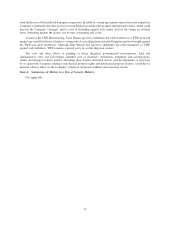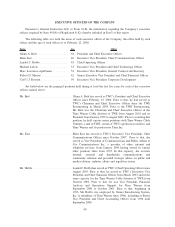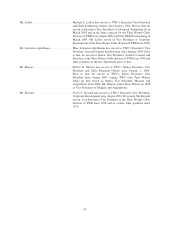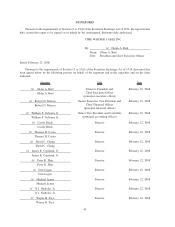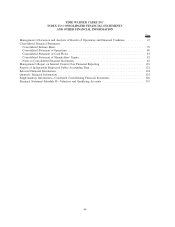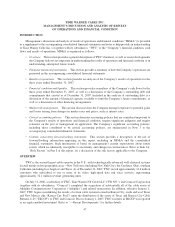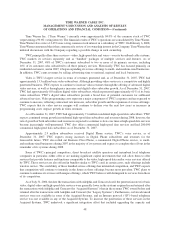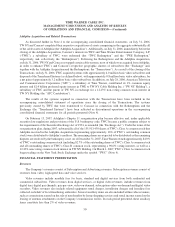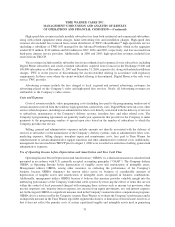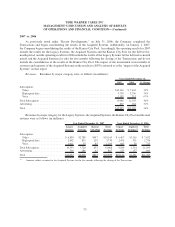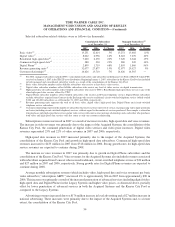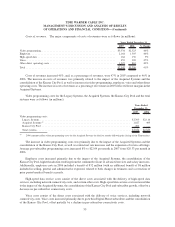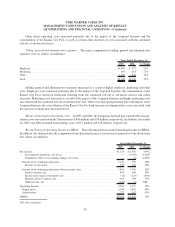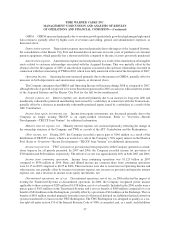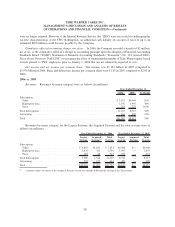Time Warner Cable 2007 Annual Report Download - page 53
Download and view the complete annual report
Please find page 53 of the 2007 Time Warner Cable annual report below. You can navigate through the pages in the report by either clicking on the pages listed below, or by using the keyword search tool below to find specific information within the annual report.Time Warner Inc. (“Time Warner”) currently owns approximately 84.0% of the common stock of TWC
(representing a 90.6% voting interest). The financial results of TWC’s operations are consolidated by Time Warner.
Time Warner also owns a 12.43% non-voting common stock interest in a subsidiary of TWC. On February 6, 2008,
Time Warner announced that it has commenced a review of its ownership interest in the Company. Time Warner has
initiated discussions with the Company regarding a possible change in such ownership.
TWC principally offers three services—video, high-speed data and voice—over its broadband cable systems.
TWC markets its services separately and as “bundled” packages of multiple services and features. As of
December 31, 2007, 48% of TWC’s customers subscribed to two or more of its primary services, including
16% of its customers who subscribed to all three primary services. Historically, TWC has focused primarily on
residential customers, and in 2007, it began expanding its service offerings to small- and medium-sized businesses.
In addition, TWC earns revenues by selling advertising time to national, regional and local businesses.
Video is TWC’s largest service in terms of revenues generated and, as of December 31, 2007, TWC had
approximately 13.3 million basic video subscribers. Although providing video services is a competitive and highly
penetrated business, TWC expects to continue to increase video revenues through the offering of advanced digital
video services, as well as through price increases and digital video subscriber growth. As of December 31, 2007,
TWC had approximately 8.0 million digital video subscribers, which represented approximately 61% of its basic
video subscribers. TWC’s digital video subscribers provide a broad base of potential customers for additional
advanced services. Video programming costs represent a major component of TWC’s expenses and are expected to
continue to increase, reflecting contractual rate increases, subscriber growth and the expansion of service offerings.
TWC expects that its video service margins will continue to decline over the next few years as increases in
programming costs outpace growth in video revenues.
As of December 31, 2007, TWC had approximately 7.6 million residential high-speed data subscribers. TWC
expects continued strong growth in residential high-speed data subscribers and revenues during 2008; however, the
rate of growth of both subscribers and revenues is expected to continue to slow over time as high-speed data services
become increasingly well-penetrated. TWC also offers commercial high-speed data services and had 280,000
commercial high-speed data subscribers as of December 31, 2007.
Approximately 2.9 million subscribers received Digital Phone service, TWC’s voice service, as of
December 31, 2007. TWC expects strong increases in Digital Phone subscribers and revenues for the
foreseeable future. TWC also rolled out Business Class Phone, a commercial Digital Phone service, to small-
and medium-sized businesses during 2007 in the majority of its systems and expects to complete the roll-out in the
remainder of its systems during 2008.
Some of TWC’s principal competitors, direct broadcast satellite operators and incumbent local telephone
companies in particular, either offer or are making significant capital investments that will allow them to offer
services that provide features and functions comparable to the video, high-speed data and/or voice services offered
by TWC. These services are also offered in bundles similar to TWC’s and, in certain cases, such offerings include
wireless service. The availability of these bundled service offerings has intensified competition, and TWC expects
that competition will continue to intensify in the future as these offerings become more prevalent. TWC plans to
continue to enhance its services with unique offerings, which TWC believes will distinguish its services from those
of its competitors.
As of July 31, 2006, the date the transactions with Adelphia and Comcast closed, the penetration rates for basic
video, digital video and high-speed data services were generally lower in the systems acquired in and retained after
the transactions with Adelphia and Comcast (the “Acquired Systems”) than in the systems TWC owned before and
retained after the transactions with Adelphia and Comcast (the “Legacy Systems”). Furthermore, certain advanced
services were not available in some of the Acquired Systems, and an Internet protocol (“IP”)-based telephony
service was not available in any of the Acquired Systems. To increase the penetration of these services in the
Acquired Systems, TWC undertook a significant integration effort that included upgrading the capacity and
48
TIME WARNER CABLE INC.
MANAGEMENT’S DISCUSSION AND ANALYSIS OF RESULTS
OF OPERATIONS AND FINANCIAL CONDITION—(Continued)



